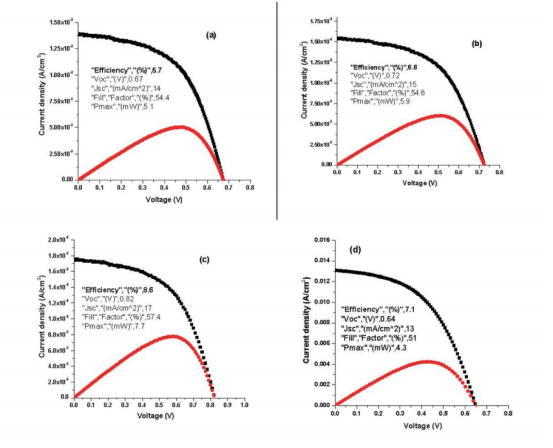
量子效率测试仪
PL/EL一体机
Sinton硅片少子寿命测试仪
Sinton硅块少子寿命测试仪
绒面反射率测试仪
3D共聚焦显微镜
清洗制绒工作站
在线四探针方阻测试仪
全自动扫描四探针方阻测试仪
在线薄膜厚度测试仪
晶化率测试仪
Horiba显微共焦拉曼光谱仪
傅里叶红外光谱仪
霍尔效应测试仪
分光光度计
全光谱椭偏仪
Horiba椭圆偏振光谱仪
TLM接触电阻率测试仪
超景深显微镜
网版智能影像测量仪
全自动影像测量仪
卧式拉力机
电池片稳态光衰老化试验箱
电池片紫外老化试验箱
电池片拉脱力综合测试仪
外观检验台
湿漏电测试系统
组件实验室EL测试仪
紫外老化试验箱
稳态光衰老化试验箱
电流连续性监测系统
PID测试系统
旁路二极管测试系统
LeTID测试系统
反向电流过载系统
脉冲电压测试系统
绝缘耐压测试仪
接地连续性测试仪
绝缘耐压接地测试仪
湿热环境试验箱
湿冻环境试验箱
热循环试验箱
动态机械载荷测试机
静态机械载荷测试机
冰雹冲击试验机
引出端强度试验机
霰弹冲击试验机
抗划伤(切割)测试机
剥离试验机
万能材料试验机(单臂)
万能材料试验机(双臂)
光伏玻璃透过率测试仪
醋酸测试试验箱
交联度测试系统
二极管接线盒综合测试仪
落球冲击试验机
半自动四探针
全自动探针式台阶仪
多通道太阳能MPPT系统
Horiba稳瞬态荧光光谱仪
钙钛矿P1激光划线测试仪
钙钛矿在线膜厚测试仪
钙钛矿工艺检测工作站
手持式IV测试仪
便携式EL测试仪
手持热成像测试仪
户外组件IV测试仪
户外组件多通道测试系统
光伏逆变器电能质量测试仪
无人机EL检测仪
不同厚度的ITO薄膜光学和电学性能对光伏电池的影响
日期:2024-09-20浏览量:40
ITO由于其高透过率和导电性,已广泛应用于太阳能电池领域。ITO 薄膜的厚度对其光学性能有显著影响,随着膜厚增加,近红外区域的透过率下降,反射率在波长高于 1900nm时略有增加。使用「美能光伏」UVN2800分光光度计采集ITO薄膜的反射率和透过率数据,为分析太阳能电池的效率提供了有力支持。
ITO薄膜制备一般需要考虑:高透过性、低电阻率、合理的膜厚等因素,这就需要对其不同膜厚的光学性能、电学性能数据进行采集,以设计出参数合理的ITO薄膜。
不同厚度ITO薄膜的光学特性

不同厚度ITO薄膜的透过率和反射率
使用双光束分光光度计测量不同厚度 ITO 薄膜的光透过率(T)与波长的关系:
光透过率随薄膜厚度增加而减小,尤其是在近红外区域。在近红外区域,由于薄膜中大量自由电子与入射光发生相互作用,导致光的极化,从而使传输光谱显著降低,进而影响介电常数。透过率高度依赖于制备的ITO薄膜厚度。
同样使用双光束分光光度计测量不同厚度 ITO 薄膜的反射率(R)与波长的关系:
反射率光谱显示,对于波长高于 1900nm 的光,反射率会略有增加。然而,这与同一区域透过率的降低并不一致。随着近红外区域厚度增加,透过率的降低归因于自由载流子吸收,这在所有高载流子浓度的透明导体中都很常见。
综上所述,ITO 薄膜的透过率与膜厚呈负相关,而反射率在特定波长范围内随膜厚的变化相对较小。
ITO 薄膜的电学性质

ITO薄膜的电阻率与厚度的关系
用标准四点探针法测量了不同厚度ITO薄膜的电学性能。由图可以看出,随着ITO膜厚度从75 nm增加到375 nm,电阻率分别从29 x10-4Ω/cm降低到1.65 x10-4Ω/cm。电阻率的降低导致相对较高的电荷载流子密度,进而引起迁移率的变化。
ITO 薄膜的厚度对其电学性质有重要影响,电阻率随着厚度的增加而减小,而较低电阻率的 ITO 薄膜更有利于提高太阳能电池的效率。
ITO薄膜厚度对太阳能电池性能的影响

太阳能电池在(a)d=75nm (b)d=225 nm(c)d=325nm(d)d=375nm处的特性曲线
d = 75nm 时:效率为 5.7%,开路电压(Voc)为 0.67V,短路电流密度(Jsc)为 14mA/cm²,填充因子(FF)为 54.4%,最大功率(Pmax)为 5.1mW。
d = 225nm 时:效率为 6.6%,Voc 为 0.72V,Jsc 为 15mA/cm²,FF 为 54.6%,Pmax 为 5.9mW。
d = 325nm 时:效率最高,为 8.6%,Voc 为 0.82V,Jsc 为 17mA/cm²,FF 为 57.4%,Pmax 为 7.7mW。
d = 375nm 时:效率为 7.1%,Voc 为 0.64V,Jsc 为 13mA/cm²,FF 为 51%,Pmax 为 4.3mW。
从图中可以看出,随着 ITO 薄膜厚度的增加,太阳能电池的性能先提高后降低。当 ITO 薄膜厚度为 325nm 时,太阳能电池的性能最佳。这表明 ITO 薄膜的厚度对太阳能电池的性能有重要影响,合适的ITO薄膜厚度可以提高太阳能电池的光电转换效率。
随着 ITO 薄膜厚度的增加,透过率在近红外区域特别是 NIR 区域下降。透过率高度依赖于制备的薄膜厚度,ITO 薄膜的厚度对其透过率和反射率有显著影响。
美能分光光度计
联系电话:400 008 6690
美能分光光度计在光伏领域中主要用来测TCO和非晶硅、微晶硅等薄膜材料的反射率和透过率,应用较多的为ITO薄膜。全设备采用独特的双光束光学设计,可以完美地校正不同样品基质的吸光度变化,测试范围广、精度高、稳定性好。
■ 采用双光源双检测器设计,波长范围190-2800nm
■ 双光栅光学结构,有效降低杂散光
■ 积分球直径可达100mm,涂层在可见区的反射率优于99%
ITO 薄膜的厚度对其光学特性有显著影响,包括透过率、反射率、吸收系数和光学带隙等。这些变化与薄膜的微观结构、晶体质量以及载流子浓度等因素有关。美能分光光度计UVN2800完全可以满足在190-2800nm全波段采集ITO薄膜的反射率、透过率数据的需求,被广泛应用于光伏行业中。




































































